 W
WThe large bird genus Columba comprises a group of medium to large pigeons. The terms "dove" and "pigeon" are used indiscriminately for smaller and larger Columbidae, respectively. Columba species – at least those of Columba sensu stricto – are generally termed "pigeons", and in many cases wood-pigeons. The rock dove ,has given rise to the majority of domesticated pigeon breeds, such as the racing pigeon and the fantail pigeon some of which have become feral. Meanwhile, "wood pigeon" by itself usually means the common wood pigeon.
 W
WThe afep pigeon, also known as the African wood-pigeon or gray wood-pigeon, is a member of the family Columbidae which lives in the Equatorial Forests of Africa.
 W
WThe African olive pigeon or Rameron pigeon is a pigeon which is a resident breeding bird in much of eastern and southern Africa from Ethiopia to the Cape. Populations also are found in western Angola, southwestern Saudi Arabia and northern Yemen. It is locally common, although sizeable gaps in its distribution occur due to its habitat requirements.
 W
WThe Andaman wood pigeon is a species of bird in the family Columbidae. It is endemic to the Andaman and Nicobar Islands in India. Classified as 'near threatened' by the IUCN, its population is estimated as between 2,500 and 10,000 mature individuals.
 W
WThe ashy wood pigeon is a species of bird in the family Columbidae, found in temperate forests of southeastern Asia.
 W
WThe Azores wood pigeon, Columba palumbus azorica is an endemic subspecies of the common wood pigeon, located in the Atlantic Azores islands of Portugal. This endemic subspecies is the only live pigeon present in the Laurel forest habitat of the Azores Islands.
 W
WBolle's pigeon is a species of the genus Columba of family Columbidae, doves and pigeons, endemic to the Canary Islands, Spain. This bird is named after the German naturalist Carl Bolle, who was the first to distinguish it from the laurel pigeon. This wood pigeon is endemic to the laurel forest habitat.
 W
WThe Bonin wood pigeon was a pigeon endemic to Nakodo-jima and Chichi-jima in the Ogasawara Islands, south of Japan. It is known from four recorded specimens, the first from 1827 and the last from 1889. They averaged a length of 45 cm. This pigeon died out late in the 19th century as a result of deforestation, hunting, and predation by introduced rats and cats.
 W
WThe common wood pigeon is a large species in the dove and pigeon family (Columbidae), native to the western Palearctic. It belongs to the genus Columba, which includes closely related species such as the rock dove. It is locally known in southeast England as the "culver"; This name has given rise to several areas known for keeping pigeons to be named after it, such as Culver Down. It has a flexible diet, predominantly feeding on vegetable matter, including cereal crops, leading to them being regarded as an agricultural pest. Wood pigeons are extensively hunted over large parts of their range, but this does not seem to have a great impact on their population.
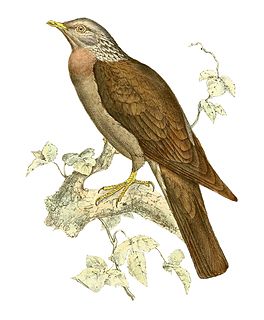 W
WThe Comoros olive pigeon, also known as the Comoro olive pigeon, is a species of bird in the family Columbidae. It is found in Comoros and Mayotte. It is becoming rare due to habitat loss.
 W
WThe domestic pigeon is a pigeon subspecies that was derived from the rock dove. The rock pigeon is the world's oldest domesticated bird. Mesopotamian cuneiform tablets mention the domestication of pigeons more than 5,000 years ago, as do Egyptian hieroglyphics. Research suggests that domestication of pigeons occurred as early as 10,000 years ago.
 W
WDoves, usually white in color, are used in many settings as symbols of love, peace or as messengers. Doves appear in the symbolism of Judaism, Christianity, Islam and Paganism, and of both military and pacifist groups.
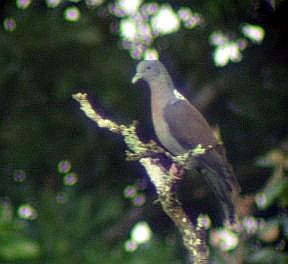 W
WThe eastern bronze-naped pigeon is a species of bird in the family Columbidae. It is found in Angola, Kenya, Malawi, Mozambique, South Africa, South Sudan, Tanzania, Uganda, Zambia, and Zimbabwe. It is part of the Turturoena subgenus. The species is named after the collector, Adulphe Delegorgue.
 W
WFeral pigeons, also called city doves, city pigeons, or street pigeons, are descended from the domestic pigeons that have returned to the wild. The domestic pigeon was originally bred from the wild rock dove, which naturally inhabits sea-cliffs and mountains. Rock, domestic, and feral pigeons are all the same species and will readily interbreed. Feral pigeons find the ledges of buildings to be a substitute for sea cliffs, have become adapted to urban life, and are abundant in towns and cities throughout much of the world.
 W
WThe hill pigeon, eastern rock dove, or Turkestan hill dove is a species of bird in the family Columbidae.
 W
WThe island bronze-naped pigeon, also known as the São Tomé bronze-naped pigeon, is a species of bird in the family Columbidae. It is endemic to the Gulf of Guinea islands of Annobón, São Tomé and Príncipe. Its natural habitat is subtropical or tropical moist lowland forest. It is part of the subgenus Turturoena. The species of birds was described by Jules and Edouard Verreaux in 1851.
 W
WThe Japanese wood pigeon is a species of bird in the genus Columba in the family Columbidae. It is found along shorelines of the East China Sea. They are believed to be the largest representative of Columba, at 550 grams (1.2 lb) and 43 cm (17 in). Its natural habitats are temperate forests and subtropical or tropical moist lowland forests. The species is in decline owing to habitat loss, habitat degradation, deforestation and hunting. This wood pigeon is endemic to the laurel forest habitat.
 W
WThe laurel pigeon or white-tailed laurel pigeon is a species of bird in the Columba genus in the family Columbidae. It is endemic to the Canary Islands, Spain, and resides in laurel forest habitat. It is the animal symbol of the island of La Gomera.
 W
WThe lemon dove or cinnamon dove is a species of bird in the pigeon family Columbidae found in montane forests of sub-Saharan Africa. The São Tomé lemon dove is usually treated as a subspecies. The lemon dove has a generally brownish-grey plumage with a cinnamon brown breast. Males have a greenish-glossed neck and white markings on the head, and females and juveniles are rather more brown and have grey facial markings. This dove is a common species, and the International Union for Conservation of Nature has rated its conservation status as being of "least concern".
 W
WThe Lord Howe pigeon, Columba vitiensis godmanae, was a subspecies of the metallic pigeon which existed on Lord Howe Island. It became extinct in the 1850s.
 W
WThe Mauritian wood pigeon is an extinct species of the pigeon genus Columba which was endemic to Mauritius. The holotype is a right tarsometatarsus collected in 1910 by Etienne Thirioux.
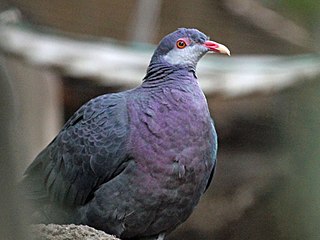 W
WThe metallic pigeon, also known as white-throated pigeon is a medium-sized, up to 37 cm long, bird in the family Columbidae.
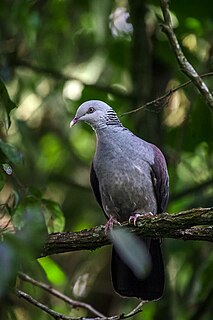 W
WThe Nilgiri wood pigeon is large pigeon found in the moist deciduous forests and sholas of the Western Ghats in southwestern India. They are mainly frugivorous and forage in the canopy of dense hill forests. They are best identified in the field by their large size, dark colours and the distinctive checkerboard pattern on their nape.
 W
WOlfactory navigation is a hypothesis put forward to explain navigation and homing of pigeons, in particular the homing pigeon.
 W
WThe pale-capped pigeon also known as the purple wood pigeon is a species of large pigeon that is found patchily distributed in parts of the Indian subcontinent and Southeast Asia. It has a slow flight and spends a lot of time sitting still in the foliage of large fruiting trees, often in riverine forest on the plains. It is mainly brown above and chestnut below with the a sheen of green or amethyst. Males have a whitish grey cap while females have a brownish grey cap and less gloss on the feathers. They are frugivores, foraging in small groups in the canopy of trees but sometimes descending to the ground for seeds and fallen fruit.
 W
WThe rock dove, rock pigeon, or common pigeon is a member of the bird family Columbidae. In common usage, it is often simply referred to as the "pigeon".
 W
WThe São Tomé olive pigeon or maroon pigeon is an endangered species of pigeon which is endemic to the island of São Tomé off the coast of western Africa. It was described by José Vicente Barbosa du Bocage in 1888.
 W
WThe silvery pigeon, also known as silvery wood-pigeon or grey wood-pigeon is a species of pigeon found in Indonesia and Malaysia. It was thought to be extinct but wild populations rediscovered in 2008 near Masokut Island might represent this species, and photographs from Simeulue confirm its existence there.
 W
WThe snow pigeon is a species of bird in the genus Columba in the family Columbidae from hilly regions of central Asia. They are grey, black, pale brown and white birds and two subspecies are recognised: C. l. leuconota occurs in the western Himalayas from western Afghanistan to Sikkum and C. l. gradaria occurs in the mountains of eastern Tibet and from eastern Nan Shan (Qinghai) to Yunnan and extreme northern Myanmar. The birds forage in open country in pairs or small groups, feeding on grain, buds, shoots, berries and seeds. They roost at night on cliffs, breeding in crevices where they build untidy stick nests and lay a clutch of usually two white eggs. The International Union for Conservation of Nature has rated the bird's conservation status as being of least concern.
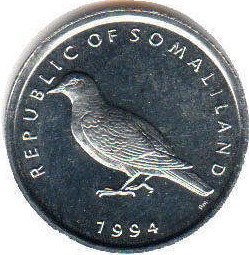 W
WThe Somali pigeon or Somali stock dove, is a species of bird in the family Columbidae. It is endemic to Somalia and Somaliland. Because there has hardly been any research on the species, the health of the population is uncertain. However, it has been suggested that the species is relatively rare. The IUCN Redlist identified a possible threat to the species from the speckled pigeon.
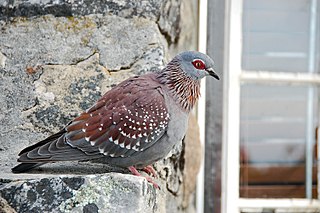 W
WThe speckled pigeon, or (African) rock pigeon, is a pigeon that is a resident breeding bird in much of Africa south of the Sahara. It is a common and widespread species in open habitats over much of its range, although there are sizable gaps in its distribution. It is sometimes referred to as the Guinea pigeon due to its similar coloring to some species of guineafowl.
 W
WThe speckled wood pigeon is a medium-sized pigeon of the family Columbidae which lives in montane forests of Kashmir to Northeast India, eastern Tibet, central China, Yunnan and Myanmar.
 W
WThe Sri Lanka wood pigeon is a pigeon which is an endemic resident breeding bird in the mountains of Sri Lanka.
 W
WThe stock dove is a species of bird in the family Columbidae, the doves and pigeons. It is widely distributed in the western Palearctic.
 W
WThe trocaz pigeon, Madeira laurel pigeon or long-toed pigeon is a pigeon which is endemic to the island of Madeira. It is a mainly grey bird with a pinkish breast; its silvery neck patch and lack of white wing markings distinguish it from its close relative and probable ancestor, the common wood pigeon. Its call is a characteristic six-note cooing, weaker and lower-pitched than that of the wood pigeon. Despite its bulky, long-tailed appearance, this pigeon has a fast, direct flight.
 W
WTurturoena, commonly called bronze-naped pigeon, is a pigeon subgenus comprising three species: the eastern bronze-naped pigeon, the western bronze-naped pigeon, and the São Tomé bronze-naped pigeon.
 W
WThe western bronze-naped pigeon is a species of bird in the family Columbidae, part of the subgenus Turturoena. A medium sized bird, it has a pale, broad terminal tail band which is noticeable on landing. It is found in most countries of Africa. The IUCN Red List classifies it as a species of least concern.
 W
WThe white-collared pigeon is a species of bird in the family Columbidae.
 W
WThe white-headed pigeon is a pigeon native to the east coast of Australia, belonging to the same genus as the domestic pigeon C. livia.
 W
WThe white-naped pigeon is a species of bird in the family Columbidae. It has a disjunct range of presence: in the mountains of Cameroon on one hand and the Albertine Rift montane forests on the other.
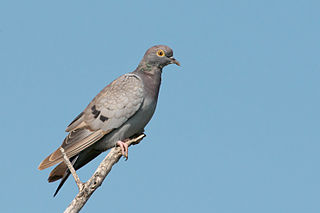 W
WThe yellow-eyed pigeon or pale-backed pigeon is a member of the family Columbidae. It breeds in southern Kazakhstan, Uzbekistan, Turkmenistan, Tajikistan, Kyrgyzstan, Afghanistan, north-east Iran and extreme north-west China. It winters in north-east Pakistan, Jammu and Kashmir and parts of Rajasthan. The bird has declined in numbers over the years, chiefly because of hunting, and it is listed as "vulnerable" by the International Union for Conservation of Nature.